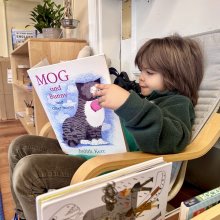
How Children Learn to Read: A Guide to Foundational Literacy Skills
by Caroline Doctor, Literacy Specialist
Learning to read is a major milestone in early childhood, but unlike speaking, it is not something our brains are naturally wired to do. While our brains have evolved to process spoken language effortlessly, written language is a relatively modern invention. Because of this, we must build entirely new neural pathways to learn to read, connecting different areas of the brain to decode symbols on a page into meaning. This process takes time, explicit instruction, and repeated practice.
At Kingsley, we recognize that learning to read is a journey—one that looks different for every child. However, there are essential foundational skills that all students must develop to become confident, capable readers. Understanding these key building blocks of literacy can help you support your child’s learning at home. Here are the fundamental skills your child will need as they learn to read:
1. Phonological Awareness
Before your child even begins reading printed words, they must develop phonological awareness—an understanding that spoken language is made up of individual sounds (phonemes). This includes skills like rhyming, clapping out syllables, and identifying beginning and ending sounds in words. Playing word games, singing songs, and reading rhyming books together can all strengthen this skill.
2. Letter-Sound Knowledge
Recognizing that letters represent sounds—and understanding the relationships between them—is a fundamental step in learning to read. Montessori materials, such as sandpaper letters, allow children to experience letters through multiple senses, reinforcing the connection between symbols and sounds. You can support this at home by encouraging your child to practice letter names and sounds through play and everyday interactions.
3. Decoding
Decoding, or sounding out words, is the next critical step. Once your child recognizes letters and their corresponding sounds, they must learn to blend those sounds to form words. In our classrooms, we use a phonics-based approach that allows children to practice decoding in meaningful, structured ways. You can support this skill by encouraging your child to read aloud and providing books that match their phonics level.
4. Vocabulary Development
A strong vocabulary is essential for reading comprehension. Children who are exposed to a rich variety of words through conversation and read-alouds develop a deeper understanding of language. You can help by engaging your child in discussions, introducing new words in everyday contexts, and reading a variety of books together.
5. Fluency
Fluency is the ability to read smoothly and accurately with appropriate expression. This develops through practice and repeated exposure to words in print. As your child gains confidence, they begin to read more automatically, freeing up cognitive space for comprehension. One key part of fluency is the automatic recognition of high-frequency words (sometimes referred to as sight words), allowing your child to read more effortlessly without needing to sound out every word. Encouraging rereading of familiar books, strengthening knowledge of high-frequency words, and modeling expressive reading can support fluency.
6. Comprehension
The ultimate goal of reading is comprehension—understanding and interpreting the text. Your child must learn to make predictions, ask questions, and connect new information to what they already know. Exposure to a variety of text types is essential for building the background knowledge necessary for strong comprehension. You can foster comprehension by discussing stories, asking open-ended questions, and encouraging your child to retell events in their own words.
Supporting Literacy at Home
You play a crucial role in your child’s literacy development. Here are some simple but effective ways to nurture these skills at home:
- Read with your child daily, exposing them to a variety of books.
- Play word and sound games that build phonological awareness.
- Encourage writing and drawing to strengthen fine motor and letter recognition skills.
- Model a love for reading by sharing your own reading experiences.
By understanding how reading develops and supporting these foundational skills, you can help your child build the neural connections necessary for lifelong literacy success. The journey to becoming a confident reader starts early, and with your support, your child can develop the skills they need to thrive. Every small step you take—reading together, encouraging curiosity, and celebrating progress—helps lay the foundation for a lifelong love of reading.
Want more information or additional ideas for at-home practice?
Click here: Supporting Emergent and Early Readers at Home
Caroline Doctor is a literacy specialist certified in Orton-Gillingham at the Associate Level and Wilson Reading System Level 1. She holds a Master of Arts in Teaching in Elementary Education and has been teaching for fifteen years.







.jpg&command_2=resize&height_2=85)







.jpg&command_2=resize&height_2=85)
.jpg&command_2=resize&height_2=85)





